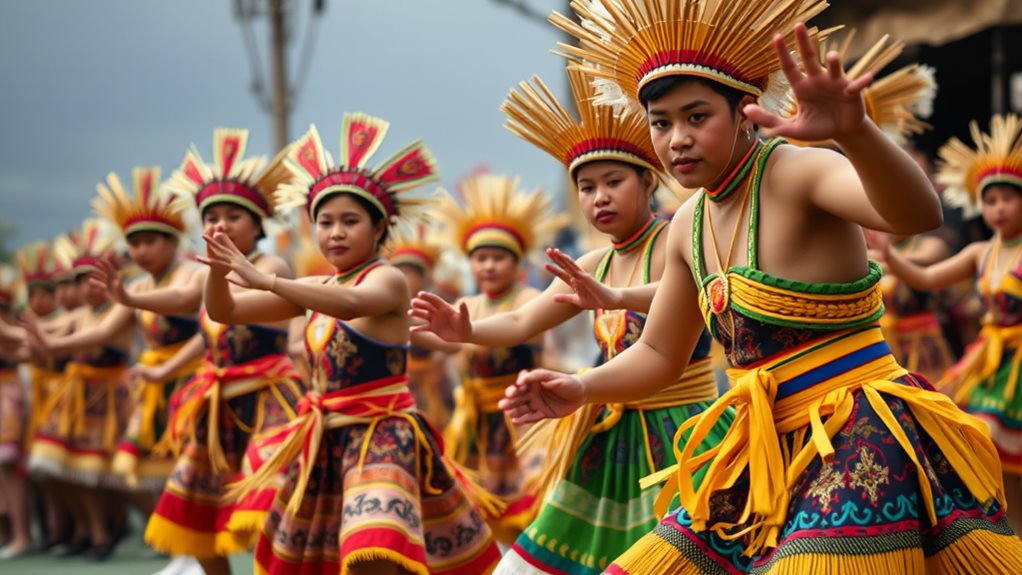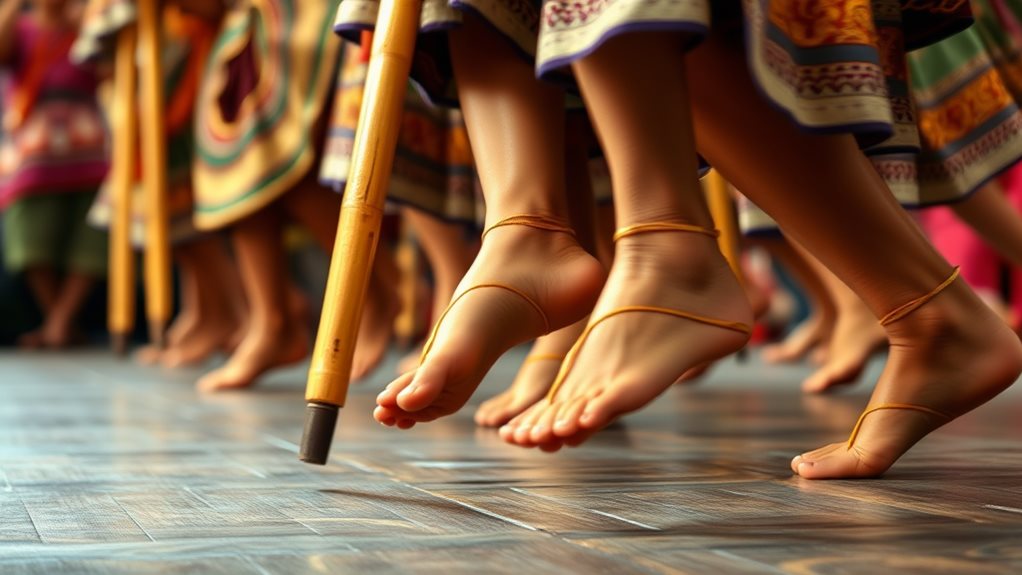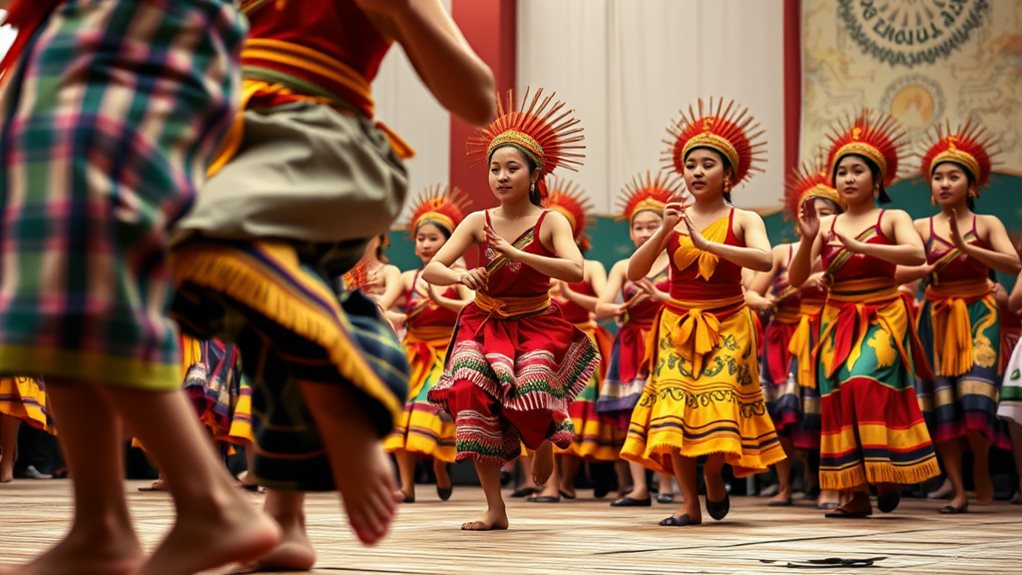The Tinikling dance has regional variations that add complexity to the core steps. Four poles are used instead of two in some areas, creating more intricate patterns. For example, in certain regions of the Philippines, dancers use the additional poles to create crisscross patterns and weave between them.
The music also varies across regions. Traditional folk tunes are used in some areas, while others feature modern pop music. This difference in music style affects the overall tempo and rhythm of the dance.
Regional variations in choreography are also notable. Some versions feature intricate turns and circular movements**, which are not seen in other versions of the Tinikling dance. For instance, dancers in one region may incorporate rapid turns**, while others may focus on fluid, circular movements.
These regional differences reflect the Philippines' diverse cultural heritage and the rich tapestry of the Tinikling dance.
Tinikling's Humble Beginnings

The Origins of Tinikling Dance****
Tinikling dance originated in the Philippines, specifically on the island of Leyte, during the Spanish colonial era. The dance is named after the *tikling* bird, known for its agility and long legs. The dance mimics the bird's movements, showcasing a connection to the natural world.
The origins of tinikling also have a darker side, with legends suggesting it emerged as a punishment for slow workers or those who defied Spanish orders. These workers were forced to avoid clapping bamboo poles, a challenging task that required quick reflexes.
However, this harsh origin story highlights the transformative power of folk traditions. What started as a survival tactic evolved into a vibrant artistic expression.
The Evolution of Tinikling Dance
The dance has shown remarkable adaptability, transitioning from a punitive act to a celebrated part of Filipino festivals and school events. This shift demonstrates how oppression can unintentionally nurture cultural resilience.
Tinikling has also spread globally, particularly to the United States, showcasing its enduring appeal. The dance's ability to thrive despite its humble beginnings is a testament to Filipino ingenuity and the power of folk traditions.
Cultural Resilience
Cultural resilience isn't just about surviving; it's about thriving. Tinikling dance embodies this concept, transforming hardship into a vibrant artistic expression.
The dance's evolution showcases the Filipino spirit, highlighting the ability to turn adversity into a symbol of cultural strength. This resilience is a key aspect of Filipino culture, allowing traditions like tinikling to endure and flourish.
Traditional Tinikling Attire
Traditional Tinikling Attire Reflects Filipino Culture****
Tinikling's rich visual tradition is reflected in the dancers' attire, which holds significant cultural meaning. The attire is deeply rooted in Filipino culture and isn't just a costume, but an expression of national pride.
Women's Attire
Women traditionally wear either the Balintawak dress, a vibrant, knee-length garment with distinctive butterfly sleeves, or the Patadyong, a checkered skirt paired with a thin-fibered blouse.
The Balintawak dress features arched sleeves and bright colors, while the Patadyong's checkered pattern adds visual interest.
Men's Attire
Men wear the Barong Tagalog, the country's national outfit, which is a light, long-sleeved embroidered shirt.
It's usually worn untucked with red trousers, showcasing intricate embroidery that speaks to Filipino craftsmanship.
Importance of Attire
The choice of attire carries significant weight, representing cultural values and traditions.
Both men and women perform barefoot, emphasizing their connection to the earth.
The absence of footwear grounds the dancers and connects them to the dance's origins.
The vibrant colors, intricate embroidery, and distinctive styles all contribute to the overall aesthetic, making the attire a powerful visual representation of Filipino heritage.
Mastering Basic Tinikling Steps

Mastering Basic Tinikling Steps
Mastering basic Tinikling steps requires practice and coordination. The foundational steps spring from a deceptively simple pattern.
Initial Foot Placement and Basic Footwork****
Begin with your feet positioned to the right of the poles. The basic footwork techniques involve a sequence: right foot in, left foot in, right foot out to the right; then left foot in, right foot in, left foot out to the left. The foot that's up on the third beat remains up, maintaining the rhythm.
Rhythm Synchronization
Rhythm synchronization is crucial. The tappers, using poles or jump bands, follow a distinct pattern: apart, apart, together. They slide the poles together without lifting them, creating a rhythmic pulse. You must step in and out in perfect sync**. For safety, only one dancer at a time should perform over the moving poles**.
Equipment and Safety
Use two parallel poles – bamboo traditionally, but PVC pipes are a viable alternative. Space the poles about two feet apart, using gym floor lines as a guide. Add 2x4s or cabinet handles to the pole ends for a secure grip. Maintain ample space between pole sets to prevent collisions.
Progressive Practice
Practice should be progressive. Begin with gym lines, advancing to jump bands before finally utilizing poles. Master the basic steps before tackling more advanced moves**. Prioritize student organization** and safety when grouping and performing.
Leyte's Unique Tinikling Styles
Leyte's unique Tinikling styles can be attributed to the dance's origins in the region. The Leyte rhythms are noticeably faster and more complex compared to other regional styles. These variations reflect the energy and spirit of the local community, characterized by quicker, sharper steps that showcase a higher level of technical proficiency.
The dancers' movements, mimicking the agile tikling birds, are influenced by the dance's historical context. The footwork in Leyte's style is distinct, with dancers' feet moving rapidly and precisely between the bamboo poles, emphasizing agility and speed****. This precision is a result of the dance's possible origins as a challenging test of skill and dexterity.
Regional influences have shaped the dance's style, resulting in subtle differences in steps and overall energy. The local culture is reflected in the unique emphasis on footwork, where dancers' feet move rapidly and precisely between the bamboo poles.
Leyte's Tinikling is a captivating spectacle, showcasing the dance's evolution under the influence of local traditions. Comparing Leyte's interpretations with others highlights the unique regional variations within the broader context of the Tinikling dance.
Tinikling Variations Across the Islands

Tinikling's Regional Variations Reflect the Philippines' Cultural Diversity****
The traditional Philippine folk dance, Tinikling, has a rich array of regional variations that reflect the unique cultural landscape of each island. While the fundamental movements of the dance remain consistent, regional adaptations significantly diversify the dance techniques.
The Basic Structure and Regional Adaptations
The basic two-pole structure, originating in Leyte and Samar, is the foundation of Tinikling. However, in some regions, this structure expands to incorporate four poles, arranged in a tic-tac-toe or cross pattern.
This increase in poles dramatically alters the dance's complexity, demanding greater agility and precision from the performers.
Choreography and Regional Influences
While the traditional version relies heavily on hopping and jumping movements, mirroring the tikling bird's agility, some regional versions introduce intricate turns and circular patterns****, adding layers of visual complexity.
These regional adaptations often reflect local traditions and cultural influences.
Regional Differences in Music
The accompanying music also varies by region. Traditional versions maintain a connection to folk songs focusing on rice cultivation and trap-setting.
In contrast, modern interpretations frequently integrate pop music, maintaining the dance's relevance to contemporary audiences. The music's tempo and rhythm continue to play a pivotal role, dictating the speed and intensity of the dancers' movements.
The Interplay Between Tradition and Innovation****
The evolution of Tinikling exemplifies the continuous interplay between tradition and innovation.
This interplay highlights the vibrant adaptability of Tinikling across the Philippine archipelago, creating a captivating spectacle that reflects both its history and enduring popularity.
Beyond Bamboo: Alternative Tools
While bamboo remains the traditional material for Tinikling, alternatives are being explored due to its limitations in accessibility and durability.
PVC pipes are a durable and cost-effective solution**. They typically range from 7 to 12 feet in length, accommodating dancers of various heights. Adding cabinet handles improves grip and control. For safety, place them on parallel** lines on the floor.
Wooden dowels offer another alternative, readily available from local lumber yards. These come in varying lengths, but 8 to 18 feet is a common range. They provide a different feel compared to PVC, offering a potentially more natural, though potentially less durable, experience.
Jump bands provide a complete departure from poles. These elastic bands, operated by foot, offer a safer and more accessible alternative****, particularly for beginners. Dancers move rhythmically in and out of the bands.
To enhance safety, regardless of the material used:
- Place 2x4s under the poles to protect your hands.
- Use carpeting samples or tape marks to protect floors and guide pole placement.
- Ensure poles are parallel and at a safe distance to prevent accidents.
- Consider the material's weight and sturdiness to avoid injuries.
Selecting the right alternative material involves balancing accessibility, cost, durability, and safety enhancements. Each option provides a unique experience, allowing you to explore the nuances of Tinikling beyond traditional bamboo.
Global Interpretations of Tinikling

Tinikling, a traditional Filipino dance, has evolved through its global adaptations.
Tinikling's expansion worldwide has resulted in diverse interpretations, transforming the dance into a vibrant reflection of its adopted homes. Cultural adaptations are apparent in music choices, with pop music or other genres replacing traditional Filipino tunes, reflecting modern influences.
The dance itself has also evolved, incorporating more dancers or bamboo poles, increasing complexity. For example, in schools across the U.S., Tinikling is integrated into physical education or cultural enrichment programs, showcasing its adaptability.
Modern choreography blends contemporary dance moves with traditional Tinikling, creating unique styles. The use of synchronized lighting or digital backgrounds in performances adds another layer to the dance, highlighting the impact of technological integration.
These adaptations reflect how cultural exchange and modern technology affect the interpretation and execution of the dance. Tinikling's multifaceted presence is showcased in its use in school curricula, community events, fitness programs, and cross-cultural workshops around the globe.
The dance's incorporation into visual art, literature, photography, and theater further expands its reach and emphasizes its enduring cultural significance. Artistic interpretations reveal not only the dance's physicality but also its deeper symbolic meaning, such as its representation of cultural identity and community.
Through these various adaptations, Tinikling transcends its origins, becoming a global phenomenon while retaining its core identity.
Tinikling's Cultural Impact
The Tinikling dance is a vibrant expression of Filipino culture, boasting a rich history interwoven with social, political, and artistic significance.
Its origins in Leyte date back to the country's colonial past, reflecting both hardship and resilience as it mimicked the tikling bird's evasion of bamboo traps.
The dance has a significant impact on national identity, as it's recognized alongside the Cariñosa as a national dance, representing key Filipino traits.
These traits include resilience and joy, which are showcased through the lively spirit of Filipinos during festive occasions.
Tinikling fosters community bonding through its participatory nature, embodying the bayanihan spirit of collaborative effort.
This cooperation is reflected in the synchronized movements, requiring teamwork and coordination among the dancers.
The dance isn't purely indigenous; it showcases a blend of indigenous and Spanish influences****, reflecting the complex cultural heritage of the Philippines.
Its rhythm has similarities to the Fandango, demonstrating how cultural exchange shapes artistic expressions.
Tinikling is taught in schools, promoting physical fitness and cultural understanding.
It serves as a vibrant link between generations, preserving national heritage for future generations to experience.
Preserving Tinikling's Legacy

Preserving Tinikling's Legacy
The preservation of cultural heritage, such as the Tinikling dance, requires a multifaceted approach that involves both formal education and community engagement. One effective method is through the incorporation of Tinikling into university curricula, as seen in the University of the Philippines.
By including Tinikling in their programs, universities foster the dance's cultural significance and ensure its transmission to future generations. This approach is then reinforced through collaborations with cultural groups and workshops.
Community-based preservation efforts also play a vital role in maintaining the dance's cultural significance. Vibrant Tinikling performances during traditional Visayan festivals**** showcase the dance's enduring appeal and engage the community.
Community centers and cultural organizations further contribute by hosting workshops and volunteer programs that actively involve the youth in preserving the dance.
Documenting variations of the Tinikling dance, such as the Tinikling Tabango and Tinikling ha Bayo, is essential for preserving its cultural significance. This not only involves recording the dance steps but also the traditional costumes, music, and historical narratives associated with the dance.
While modern adaptations of Tinikling may dilute some traditional aspects, they also broaden the dance's reach and strengthen its cultural significance by engaging a wider audience.
A concerted effort from both formal education and community participation is vital for safeguarding Tinikling's legacy.
Questions and Answers
What Music Is Traditionally Used for Tinikling?
Tinikling traditionally uses music from a rondalla, a string ensemble. A rondalla is an ensemble of string instruments typically consisting of a guitar, bandurria, laud, and octavina. It creates a lively, fast-paced 3/4 rhythm, which is characteristic of traditional Tinikling music.
How Many Dancers Are Typically Involved?
A typical dance performance involves three to four dancers. This number allows for precise dancer coordination and varying formations, which are essential in creating visually appealing performances. In contrast, a solo dancer's role focuses on individual expression and technique, differing from the group dynamic.
Are There Age Restrictions for Dancers?
There are no age restrictions for dancers in the dance community. Dance forms like Tinikling, a traditional Filipino dance, can be performed by people of all ages, from children to elders. This inclusive nature is a testament to the cultural significance and enduring appeal of dance.
What Are Common Injuries Sustained While Dancing?
Dancers often experience lower extremity injuries. This is particularly true for the ankles and feet, where improper foot placement can lead to a variety of problems. For instance, ankle sprains and strains can occur from landing incorrectly from jumps or turns. Additionally, insufficient warm-up routines can increase the risk of strains, sprains, and stress fractures by not adequately preparing the muscles for physical activity. However, using proper technique can minimize these issues.
How Long Does It Take to Learn Basic Steps?
The time it takes to learn Tinikling's basic steps varies depending on individual learning pace. Effective practice methods play a significant role in mastering these steps quickly. For example, using jump bands before moving on to poles can significantly reduce the learning time.